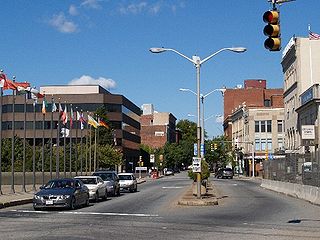
Fall River is a city in Bristol County, Massachusetts, United States. Fall River's population was 94,000 at the 2020 United States census, making it the tenth-largest city in the state.

The Blackstone River is a river in the U.S. states of Massachusetts and Rhode Island. It flows approximately 48 mi (80 km) and drains a watershed of approximately 540 sq. mi (1,400 km2). Its long history of industrial use has left a legacy of pollution, and it was characterized by the United States Environmental Protection Agency in 1990 as "the most polluted river in the country with respect to toxic sediments."
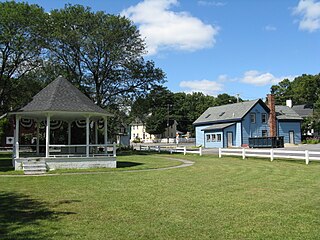
Assonet is one of two villages in the town of Freetown, Massachusetts in Bristol County, Massachusetts, United States. An original part of the town, Assonet was settled in 1659 along with the city of Fall River, then a part of Freetown. It rests on the banks of the Assonet River. As of the 2000 census, the village had a total population of 4,084; up from 3,614 in 1990. As of the 2014 census the village had a total estimated population of 9,093.

The Boston Manufacturing Company was a business that operated one of the first factories in America. It was organized in 1813 by Francis Cabot Lowell, a wealthy Boston merchant, in partnership with a group of investors later known as The Boston Associates, for the manufacture of cotton textiles. It built the first integrated spinning and weaving factory in the world at Waltham, Massachusetts, using water power. They used plans for a power loom that he smuggled out of England as well as trade secrets from the earlier horse-powered Beverly Cotton Manufactory, of Beverly, Massachusetts, of 1788. This was the largest factory in the U.S., with a workforce of about 300. It was a very efficient, highly profitable mill that, with the aid of the Tariff of 1816, competed effectively with British textiles at a time when many smaller operations were being forced out of business. While the Rhode Island System that followed was famously employed by Samuel Slater, the Boston Associates improved upon it with the "Waltham System". The idea was successfully copied at Lowell, Massachusetts, and elsewhere in New England. Many rural towns now had their own textile mills.
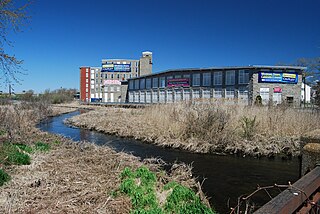
The Quequechan River is a river in Fall River, Massachusetts, that flows in a northwesterly direction from the northwest corner of the South Watuppa Pond through the heart of the city of Fall River and into the end of the Taunton River at Mount Hope Bay at Heritage State Park/Battleship Cove. The word Quequechan means "Falling River" or "Leaping/Falling Waters" in Wampanoag, hence the city's name.

Pocasset Manufacturing Company was a cotton textile mill located in Fall River, Massachusetts. It was located just west of Main Street across the second falls of the Quequechan River. It was organized on August 15, 1821, with $100,000 in capital. The mill began operation in 1822, with Samuel Rodman of New Bedford as the principal owner. Oliver Chace, served as the mill's agent until 1837. Nathaniel Briggs Borden was named clerk and treasurer.

Nathaniel Briggs Borden was a businessman and politician from Fall River, Massachusetts. He served as a U.S. Representative from Massachusetts's 10th congressional district from 1835 to 1839 and again from 1841 to 1843. He later served as a member of the Massachusetts General Court, first as a state Senator, and later a state representative. He also served as the third mayor of Fall River. His business career included interests textile mills, banking and railroads. He was the younger brother of noted land surveyor Simeon Borden.
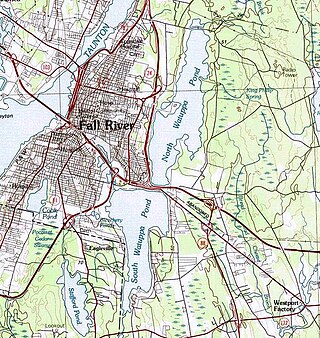
The Watuppa Ponds are two large, naturally occurring, spring-fed, glacially formed ponds located in Fall River and Westport, Massachusetts. Watuppa is a native word meaning "place of boats". The two ponds were originally one body of water, connected by a narrow rocky straight called "The Narrows" located on a thin strip of land between the two ponds which forms part boundary of between Fall River and Westport. The border between Fall River and Westport is also divided between the two ponds. Together, the ponds have an overall north–south length of about 7.5 miles, and have an average east–west width of about a mile. The ponds are drained by the Quequechan River, and flows in a westerly direction through the center of Fall River from South Watuppa Pond to Mount Hope Bay.

Saylesville is a village and historic district in Lincoln, Rhode Island.
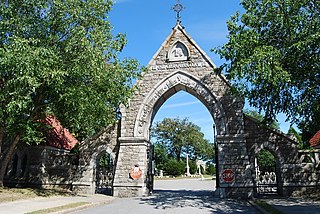
Oak Grove Cemetery is a historic cemetery located at 765 Prospect Street in Fall River, Massachusetts. It was established in 1855 and greatly improved upon in the years that followed. It features Gothic Revival elements, including an elaborate entrance arch constructed of locally quarried Fall River granite. The cemetery originally contained 47 acres, but has since been expanded to over 120 acres. The cemetery is the city's most significant, built in the planned rural-garden style of Mount Auburn Cemetery in Cambridge, Massachusetts. It was designed and laid out by local architect Josiah Brown, who is also known for his designs of early mills including the Union, Border City, and others.

For much of its history, the city of Fall River, Massachusetts has been defined by the rise and fall of its cotton textile industry. From its beginnings as a rural outpost of the Plymouth Colony, the city grew to become the largest textile producing center in the United States during the 19th century, with over one hundred mills in operation by 1920. Even with the demise of local textile productions during the 20th century, there remains a lasting legacy of its impact on the city.

The American Printing Company, located in Fall River, Massachusetts grew to become the largest producer of printed cotton cloth in the United States by the early 20th Century. The company grew as an offshoot of the Fall River Iron Works, established in 1821 by Colonel Richard Borden and Major Bradford Durfee. The American Print Works was established in 1835 by Holder Borden. It employed several thousand workers at its peak during World War I.

The Metacomet Mill, built in 1847 by Colonel Richard Borden for the manufacture of cotton textiles, is the oldest remaining textile mill in Fall River, Massachusetts.

Colonel Richard Borden (1795–1874) was an American businessman and civic leader from Fall River, Massachusetts. He co-founded the Fall River Iron Works in 1821, and later built several early cotton mills, as well as the Fall River Line, Fall River Gas Works Company, the Fall River Railroad, banks and other businesses. The Borden family would dominate the economic and civic life of Fall River into the early 20th century.

Barnard Mills is an historic textile mill at 641-657 Quarry Street in Fall River, Massachusetts. Developed beginning in 1874, it was the first mill to use ring spinners instead of mule spinners, and was a major local employer until its closure in 1939. The complex has been redeveloped as a commercial retail space called Tower Mill. The mill was added to the National Register of Historic Places in 1983.
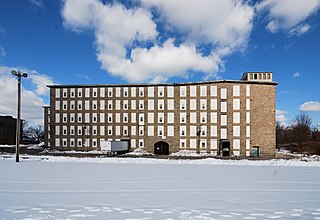
Flint Mills is a historic textile mill complex located on Alden Street in Fall River, Massachusetts, near the banks of the Quequechan River. The company was founded in 1872 and named in honor of John D. Flint, who served as its first president. The original 1872 mill burned in 1882, and was rebuilt in 1883. The complex was later expanded with a second mill and large addition in 1909. The site also contains a detached granite mill office building. The section of Fall River surrounding the mill became known as "Flint Village". The site was added to the National Register of Historic Places in 1983.

Borden Flats Light is a historic lighthouse on the Taunton River in Fall River, Massachusetts, US. It is a tower-on-caisson type known as a sparkplug lighthouse.

The Fall River Manufactory was the first cotton mill to be constructed across the Quequechan River in Fall River, Massachusetts, United States. It was also the first successful textile mill in the area.
The Lewiston Mills and Water Power System Historic District encompasses the major 19th-century mill complexes and associated water power systems in Lewiston, Maine. Developed beginning in 1850, Lewiston's canals and mills were the largest textile mill complex in the state, and one of the best-preserved mature large-scale expressions of the Lowell system of cotton textile manufacturing, perfected at Waltham and Lowell, Massachusetts earlier in the 19th century. The district includes a series power canals and mill complexes developed over a 100-year period, along with mill worker housing and transportation infrastructure. It was listed on the National Register of Historic Places in 2015.
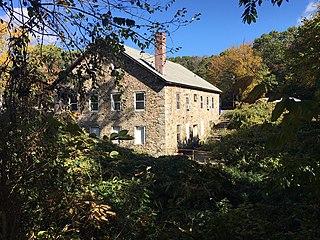
The Otis Angell Gristmill is a historic mill in Governor John Notte Memorial Park, North Providence, Rhode Island. Built about 1855, it is a well-preserved example of a small 19th-century industrial site, with a stone mill building and a small mill pond. The site was added to the National Register of Historic Places in 2017. The mill building now serves as a local community center.






















